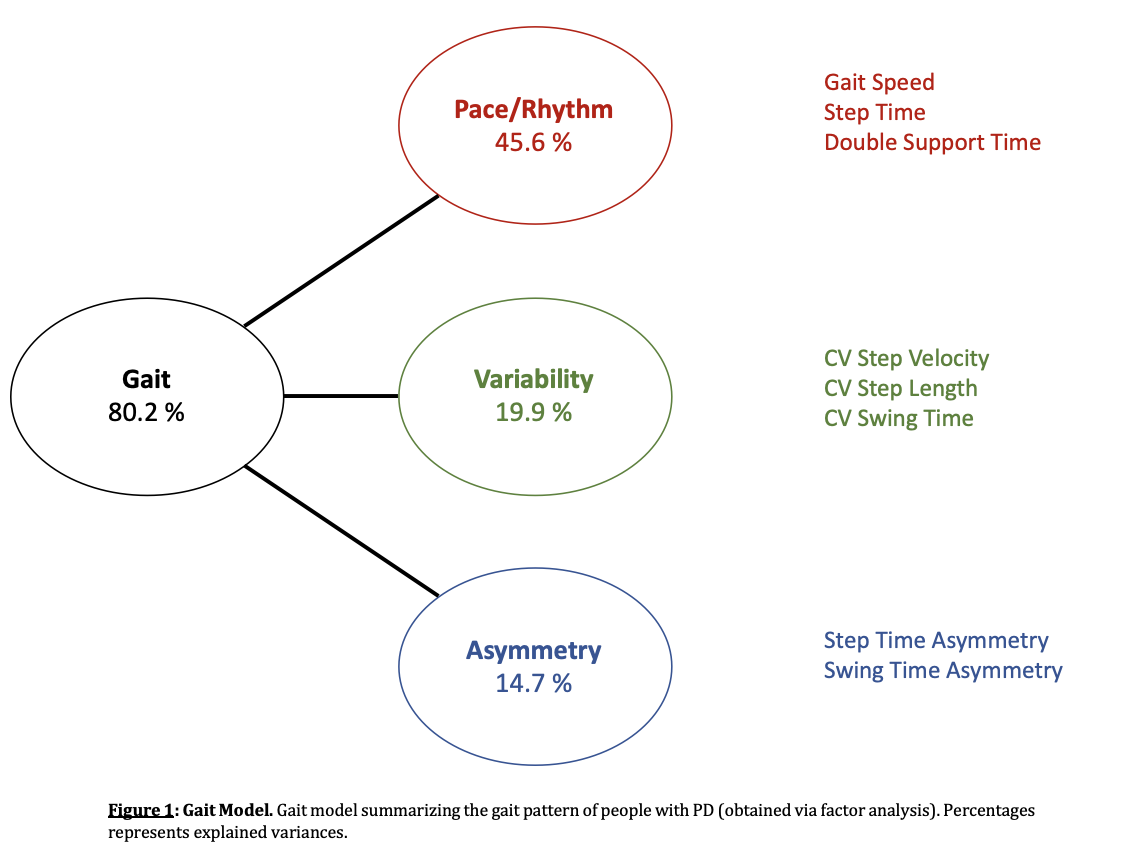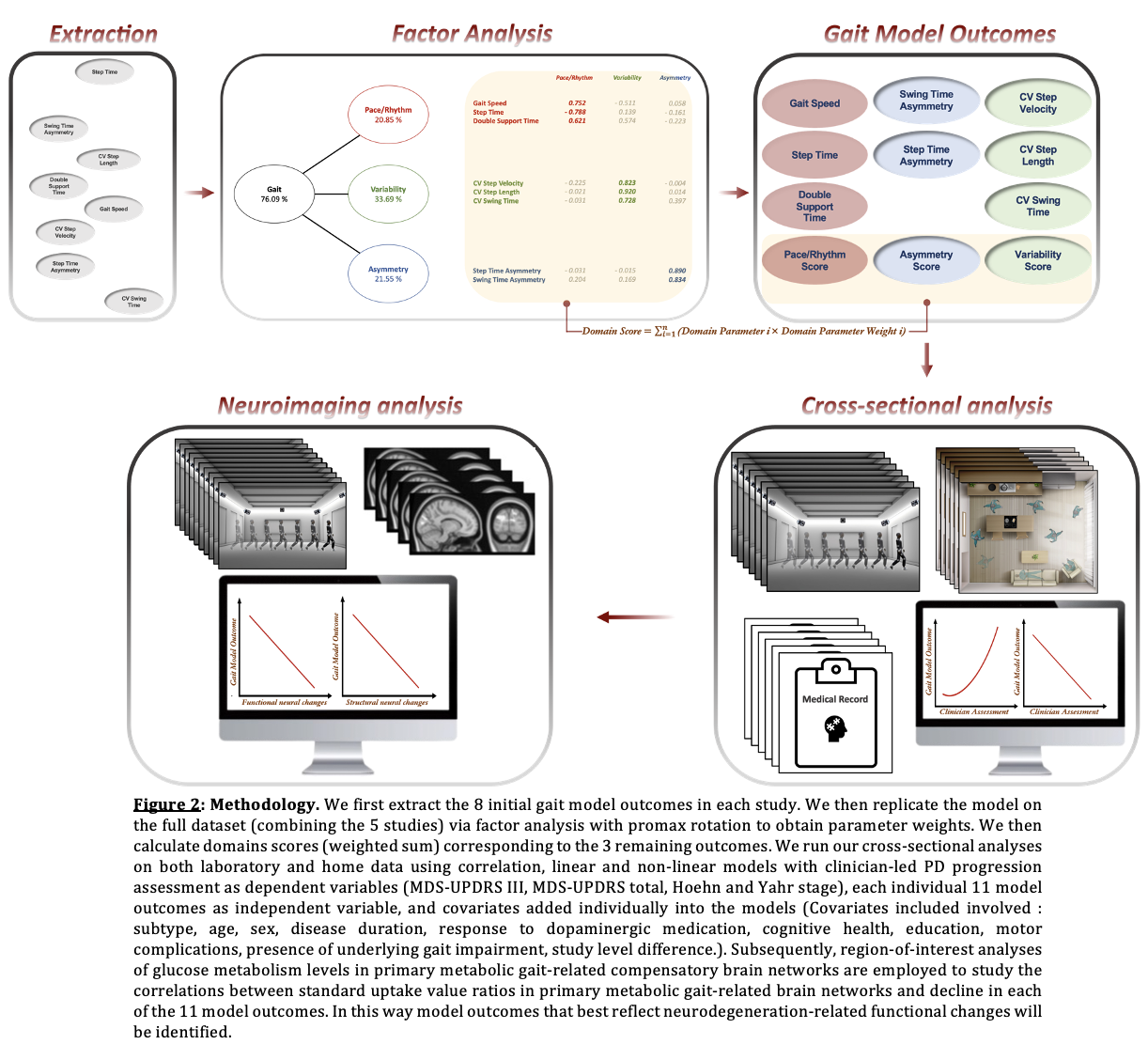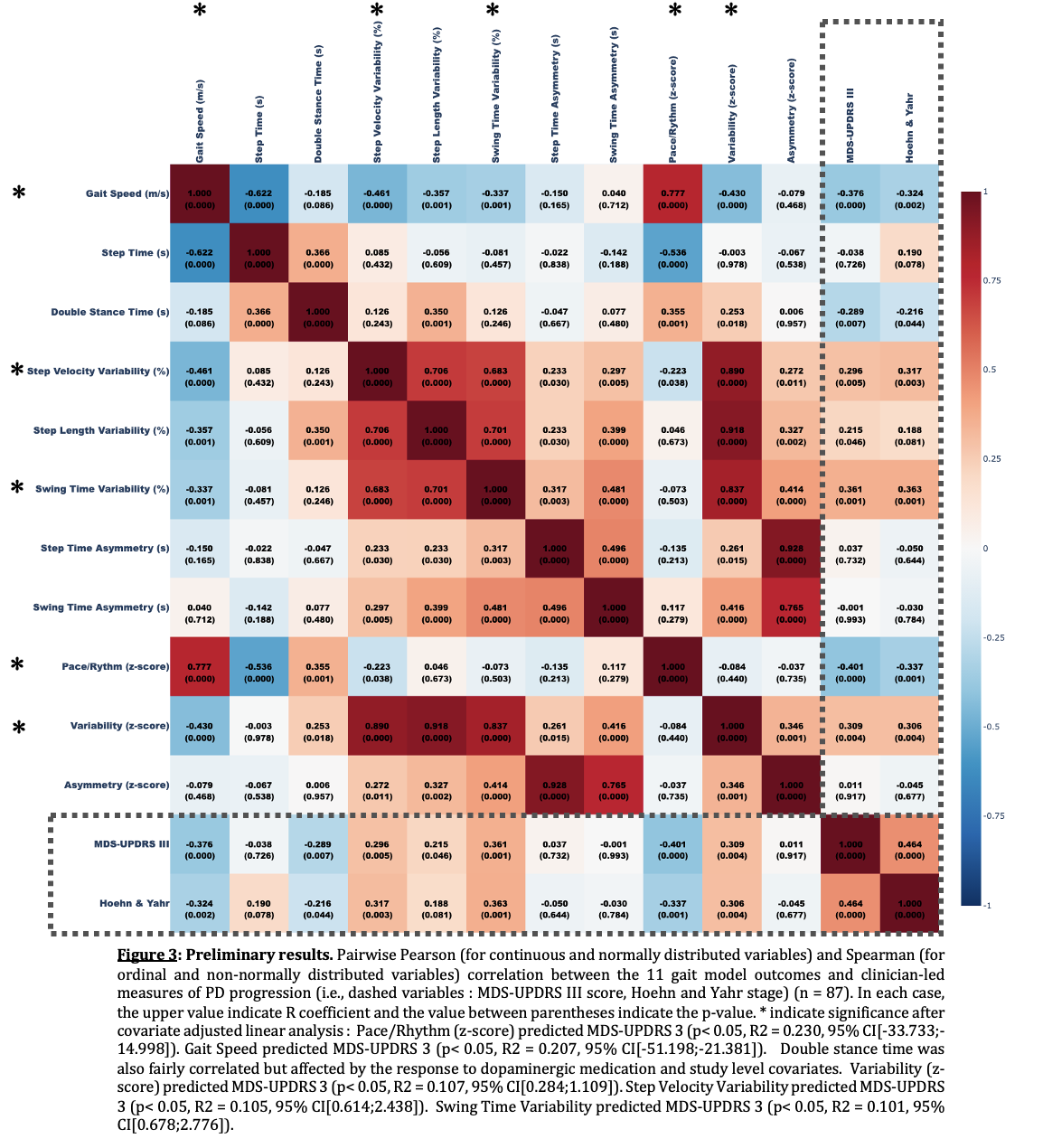Category: Technology
Objective: To determine whether outcomes extracted from a gait model can serve as markers of symptoms and neurodegeneration progression in Parkinson’s disease (PD).
Background: Longitudinal studies suggest that the decline observed in gait in PD could be a promising progression marker [1,2] that could track intervention-induced changes [3,4]. Gait speed has been proposed as progression marker [5,6], yet it does not holistically capture gait decline in PD [7,8], and previous efforts focused solely on its association with clinical scales of symptom progression [5]. Although sufficient for trials targeting symptoms [3], such an approach fails to assess the need to also reflect neurodegeneration for use in neuroprotective trials [3,4]. A recent gait model, derived via factor analysis, encompasses 11 gait outcomes reflecting overall PD-related gait decline [9,10] [figure 1]. It is unclear whether these outcomes could serve as progression markers during both symptoms and neuroprotective trials [4,8].
Method: A cross-sectional analysis is under way. Data from 167 participants with PD are being extracted from 5 studies [11–15]. The 11 outcomes will be obtained via FA. Associations between the 11 gait outcomes and clinical scales of PD symptoms progression (MDS-UPDRS and H&Y) will be examined in laboratory and home environments using correlation, covariate-adjusted linear models and restricted cubic spline models. Additionally, neuroimaging analyses will be employed to study the correlations between the 11 gait outcomes and neurodegeneration-related neural changes [16,17] [figure 2].
Results: Of the currently analyzed laboratory population (n=87/167), the gait model was successfully reproduced by FA and explained 76.09 % of the variance in gait performance. After adjusting for comorbidities and demographic factors, clinical scales of PD progression were fairly associated with pace- and temporal variability-related outcomes [figure 3].
Conclusion: Preliminary results suggest that gait model outcomes related to pace- and temporal variability can serve as markers of symptoms progression. These initial results are in line with recent neuroimaging findings suggesting that both pace and temporal variability are controlled by two neurodegeneration-related brain “gait networks” [16]. Subsequent analyses should complement current results. This investigation could consolidate the idea of using gait as an indicator of participant response in clinical trials [6].
Figure 1
Figure 2
Figure 3
References: 1. Ellis TD, Cavanaugh JT, Earhart GM, Ford MP, Foreman KB, Thackeray A, et al. Identifying clinical measures that most accurately reflect the progression of disability in Parkinson disease. Parkinsonism & Related Disorders. 2016 Apr;25:65–71.
2. Evers LJW, Krijthe JH, Meinders MJ, Bloem BR, Heskes TM. Measuring Parkinson’s disease over time: The real-world within-subject reliability of the MDS-UPDRS. Movement Disorders. 2019;34(10):1480–7.
3. Marras C, Lang AE. Outcome measures for clinical trials in Parkinson’s disease: achievements and shortcomings. Expert Review of Neurotherapeutics. 2004 Nov;4(6):985–93.
4. McGhee DJ, Royle PL, Thompson PA, Wright DE, Zajicek JP, Counsell CE. A systematic review of biomarkers for disease progression in Parkinson’s disease. BMC Neurol. 2013 Dec;13(1):35.
5. Liu Y, Zhang G, Tarolli CG, Hristov R, Jensen-Roberts S, Waddell EM, et al. Monitoring gait at home with radio waves in Parkinson’s disease: A marker of severity, progression, and medication response. Science Translational Medicine. 2022 Sep 21;14(663):eadc9669.
6. Klein C, Bloem BR. Research in movement disorders in 2022: a new era of biomarker and treatment development. The Lancet Neurology. 2023 Jan;22(1):17–9.
7. Wilson J, Alcock L, Yarnall AJ, Lord S, Lawson RA, Morris R, et al. Gait Progression Over 6 Years in Parkinson’s Disease: Effects of Age, Medication, and Pathology. Front Aging Neurosci. 2020 Oct 15;12:577435.
8. Mirelman A, Bonato P, Camicioli R, Ellis TD, Giladi N, Hamilton JL, et al. Gait impairments in Parkinson’s disease. The Lancet Neurology. 2019 Jul;18(7):697–708.
9. Arcolin I, Corna S, Giardini M, Giordano A, Nardone A, Godi M. Proposal of a new conceptual gait model for patients with Parkinson’s disease based on factor analysis. BioMedical Engineering OnLine. 2019 Jun 3;18(1):70.
10. Godi M, Arcolin I, Giardini M, Corna S, Schieppati M. A pathophysiological model of gait captures the details of the impairment of pace/rhythm, variability and asymmetry in Parkinsonian patients at distinct stages of the disease. Sci Rep. 2021 Oct 27;11(1):21143.
11. Mitchell T, Conradsson D, Paquette C. Gait and trunk kinematics during prolonged turning in Parkinson’s disease with freezing of gait. Parkinsonism & Related Disorders. 2019 Jul 1;64:188–93.
12. Gilmore G, Gouelle A, Adamson MB, Pieterman M, Jog M. Forward and backward walking in Parkinson disease: A factor analysis. Gait & Posture. 2019 Oct 1;74:14–9.
13. Levodopa Response Study | Parkinson’s Disease [Internet]. [cited 2024 Jan 26]. Available from: https://www.michaeljfox.org/news/levodopa-response-study
14. Warmerdam E, Hansen C, Romijnders R, Hobert MA, Welzel J, Maetzler W. Full-Body Mobility Data to Validate Inertial Measurement Unit Algorithms in Healthy and Neurological Cohorts. Data. 2022 Sep 27;7(10):136.
15. Shida TKF, Costa TM, De Oliveira CEN, De Castro Treza R, Hondo SM, Los Angeles E, et al. A public data set of walking full-body kinematics and kinetics in individuals with Parkinson’s disease. Front Neurosci. 2023 Feb 16;17:992585.
16. Sigurdsson HP, Yarnall AJ, Galna B, Lord S, Alcock L, Lawson RA, et al. Gait-Related Metabolic Covariance Networks at Rest in Parkinson’s Disease. Movement Disorders. 2022;37(6):1222–34.
17. Sulzer D, Cassidy C, Horga G, Kang UJ, Fahn S, Casella L, et al. Neuromelanin detection by magnetic resonance imaging (MRI) and its promise as a biomarker for Parkinson’s disease. npj Parkinson’s Disease. 2018 Apr 10;4(1):1–13.
To cite this abstract in AMA style:
CE. Mvomo, J. Bedime, S. Perfetto, I. Sierra, H. Lajeunesse, A. Potvin-Desrochers, CA. Easthope, C. Paquette. Model-Based Gait Outcomes to Track Parkinson’s Disease Progression ? [abstract]. Mov Disord. 2024; 39 (suppl 1). https://www.mdsabstracts.org/abstract/model-based-gait-outcomes-to-track-parkinsons-disease-progression/. Accessed April 1, 2025.« Back to 2024 International Congress
MDS Abstracts - https://www.mdsabstracts.org/abstract/model-based-gait-outcomes-to-track-parkinsons-disease-progression/



